人教版高中英语必修一Unit3 Journey Down The Mekong教案
人教版高中英语高一必修1 Unit3 Journey down the Mekong
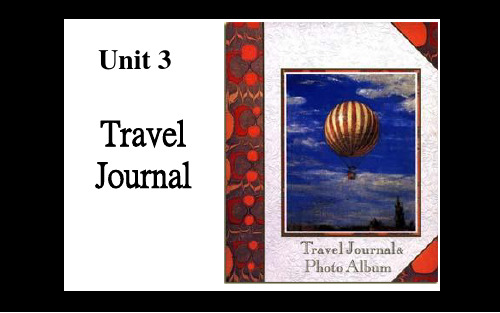
along the entire Mekong River. Wang Kun and Wang
Wei have 2._d_re_a_m__e_d (dream) about taking a bike trip ever since middle school . Wang Kun 3.__b_o_u_g_h_t_ (buy)
Unit. It is a piece of travel journal written
by Wang Kun. It mainly talks about Wan g
Kun and his sister’s dream of taking a
great bike trip down the Mekong River, their preparations for the trip and
Travel is a good way to meet the heart.
• Why do you want to go
there? (为什么?)
• What will you prepare
for this trip? (准备?)
Status and main idea of the passage The passage is the highlight of this
What does the Mekong look like?
When it runs through low valleys to the _p_l_a_i_n_s_, it makes wide bends or meanders. 平原
人教版高中英语必修1 Unit3 Journey Down the Mekong教案

Unit3Travel JournalJourney Down the MekongTeaching Aims1.To talk about traveling and how to make preparations for traveling by brainstorm and free talk.2.To learn something about the Mekong River by a brief introduction of a student.3.To guide students to find out the main idea and some details in each paragraph by sc anning and skimming the passage.Teaching important pointsTo comprehend the text is very important.Get students to find out the main idea and s ome details in each paragraph.Teaching difficult pointsHow to grasp the main idea of the text and how to tell the writer’s attitude Teaching procedures&ways教学过程和方法Pre-readingTask1: Warming upShow some beautiful pictures of famous places on the PowerPoint.(The Great Wall; Budala Palace;Forbidden City;Eiffel Tower;etc.)Ask students whether they know where they are.Task2: Free talkT:Do you like traveling?T:Why do you like traveling?(Enjoy beautiful scenery;Increase our knowledge;Make friends;Be good to health…T: If you have a chance to travel,how are you going there?(on foot;by bike;by bus;by car;by plane/by air;by boat/by ship/by sea)Task3:BrainstormMany people live beside a river,how do they make use of it in their daily life.The suggested answers:People can drink the water in a river or wash their clothes.People can swim in a river in summer.People can use a river to irrigate their fields.People can use a river to produce electricity.People can travel along a river; Raise ducks;While-readingThere are many great rivers in the world. Have you ever dreamed about travelling along one of them? Today we will follow Wang Kun and Wang Wei to travel along the Chinese part of Mekong River.Task 1 One student will introduce the Mekong River.Task 2 Co-operation study,After listening, skim the passage and find out the answers to the following questions para by para.Para.11. What was Wang Kun and Wang Wei’s idea of a good trip?2. What is the Chinese part of Mekong River?3. Who planned the trip to the Mekong?Para.21. Did Wang Wei know the best way of getting to places?2. Who insisted on organizing the trip? Why?3. What’s Wang Wei’s attitude to the trip?4. What’s Wang Kun’s attitude to the trip?Para.31. Where is the source of the Mekong and which sea does it end?2. Translate the following sentence in Chinese.It makes wide bends or meanders through low valleys to the plains where rice grows.Task 3Co-operation study fill in blanks with the help of illustrationsThe Mekong River is called _____________ in China. It goes through ____________ _____, _________, _________, _________ and pours into the ________________.Wang Kun and ___ _____ Wang Wei are dreaming about ____________________. They have the idea to _____ ______ the Mekong River from ______ it ______ to ______ it _____.It begins in a _______ on a ________ _________. Then, it ______ quickly. It becomes______ as it passes through deep ______.Sometimes, the river becomes a ________ and enters ____ ________.At last, the river _____ enters the South China Sea.Post-reading:DiscussionIn groups of four, summarize the main idea of the passage and tell why.(The passage tells us a main idea that no success in life merely happens by describing my sister’s and my dream---taking a bike trip and preparations for the trip.) Homework:Imagine that you are Wang Wei, tell your classmates your experiences about your traveling, and write it down.。
人教版高中英语必修一Unit3课文中英对照

Journey Down the Mekong沿湄公河而下的旅程My name is Wang Kun. Ever since middle school my sister Wang Wei and I have dreamed about taking a great bike trip. Two years ago she bought an expensive mountain bike and then she persuaded me to buy one. Last year she visited our cousins Dao Wei and Yu Hang at their college if Kunming. They are Dai and grew up in western Yunnan Province near the Lancang River the Chinese part of the river that is called the Mekong River in other countries. Wang Wei soon got time interested in cycling too. After graduating from college we finally got the chance to take a bike trip. I asked my sister “Where are we going?” It was my sister who first had the idea to cycle along the entire Mekong River from where it begins to where it ends. Now she is planning our schedule for the trip.我的名字叫王坤。
人教版英语必修一Unit 3(Journey Down the Mekong--the Dream and the plan)教案

Teaching Plan for Journey Down the Mekong--the Dream and the planBy Yue LiuTeaching contentsUnit 3 Travel journal Period 1 Reading. Journey down the MekongTeaching aims1.Knowledge aimsAfter the lesson,students could know how to use the pattern It is(was)... that(who)....; They could know some words such as determined/make up one’s mind/stubborn/glacier/valleyrapids/plains .2.Ability aimsStudents could make a little improvement in their reading skills to look for the details.3.Emotion aimsTo help the students know the author’s attitude s towards difficulties and tell them the right way to make a dream come true.Teaching Key points & Difficult points1. It is(was)... that(who)....2.Questions in task two and task three are difficult for them to finish,so some clues are given to help to finish them successfully.3.There are too many new words for them ,so the tasks must be designed carefully to help them understand and get the hang of the clue of the passage.4.To get most of the students involved in the class.Teaching methodsSituational teaching method、Task based teaching method、Communicative teaching method1.Situational teaching method. A video is used to bring the situation into life.2.Task based teaching method. To understand the passage by doing some tasks in classes and after-class designed tasks.municative teaching method. A lot of smiling faces are used to encourage them to cooperate and compete with each other.Teaching procedureStep 1 Warming up1. Show some pictures of the rivers2. Divide the students in 3 groups and name them after the names of the rivers.3.Watch a video about the Mekong River【Purpose】To arise the interests among students in the text.Step 2 While-reading Read the passage and finish four tasks.Task one Read Para.1 and find the answers to the following questions1.Who are Wang Kun and Wang Wei?2.What was their dream?3.Who planned the trip first and what ’s their plan?Task one plus Use emphatic sentence to stress the underlined partThe pattern It is (was) 被强调部分+ that (who) + 句子其他部分.1.Two years ago she bought an expensive mountain bike.2.Two years ago she bought an expensive mountain bike.3.Two years ago she bought an expensive mountain bike.Task two Read Para. 2 and fill in the blanks1.Can you find out two adjectives to describe Wang Wei ’s character?_______ _________2.What difficulties did Wang Wei and Wang Kun find about their journey?And what were Wang Wei ’s attitudes?Difficulties AttitudesTask three Read Para.3 and fill in the blanks1.Facing difficulties,what did they do ?Several months before our trip,Wang Wei and I______________ and found ________with ____________.2.What could they see from the atlas?glacier【Purpose 】To improve students’ skills in looking for details and make students apply reading strategies to get some information.Step 3 Post-reading Check the answers and do some summariesDream Difficulties & Attitudes PlanFree talk . Everyone has a big dream, but how to make it come true?We should __________________________Once we have_________________________,nothing can change it.We should_______________________________________________It is ______________ that plays an important role in making a dream come true.Where there is a will,there is away(有志者,事竟成).【Purpose 】To help students get a deep understanding of the passage and achieve the emotional aims.Step 4 Homework1.Write a short passage about how to make a dream come true.2. Preview the part 2 of journey down the Mekong .【Purpose 】To consolidate and enhance the knowledge that we learn from this class and get ready for the next class.The _________ is in ______province! The ____ is more than _____meters. It would be hard to _________ It’s very ______ . A ______________ lookBe_____________about it An _________ experience。
人教版英语必修一Unit 3(Reading:Journey down the Mekong)教案

Unit 3 Travel JournalReadingJOURNEY DOWN THE MEKONG▲三维目标Knowledge Aims:1. Get students to summarize and remember the main idea of thepassage — Journey down the Mekong.2. Let students know more about the Mekong River.Ability Aims:1. Enable students to learn to talk about trip.2. Develop students’ reading ability and let them learn different.reading skills.Emotional Aims:1. Arouse students’ great interest in the Mekong River.2. Develop students’ sense of cooperative learning.▲Teaching Important Points1. Let students learn more about the Mekong River.2. Get students to learn different reading skills.▲Teaching Difficult Points1. Develop students’ reading ability.2. Enable students to learn more about the Mekong River. ▲Teaching Methods1. Task-based teaching and learning2. Cooperative learning.3. Discussion.4. Skimming5. Scanning▲Teaching AidsMulti-media and other normal teaching tools.▲Teaching ProceduresStep I: Revision1.Words Reviewvt. 说服;劝说persuadevi. 骑自行车cyclevi. 毕业n. 大学毕业生graduateadv. 最后;终于finallyn. 时间表;进度表schedulevt. 为某事安排时间adj. 喜爱的;慈爱的;宠爱的fondn. 缺点shortcoming stubborn adj. 顽固的;固执的organize vt. 组织;成立detail n. 细节;详情source n. 来源;水源determine vt. 决定;确定;下定决心determined adj. 坚决的;有决心的\ journey n. 旅行;旅程altitude n. 海拔高度;高处n. 地图;地图集atlasn. 冰河;冰川glaciern. 急流rapidsn.(山)谷;流域valleyn. 瀑布waterfallvi. 缓慢而行;踱步pacen. 一步;速度;步调n. 弯;拐角bendvt. 使弯曲vi. 弯身;弯腰2.Match 改变主意ever since 下决心; 决定be fond of 投降; 屈服; 让步care about 从那以后change one’s mind喜爱; 喜欢give in 关心; 忧虑; 惦念make up one’s mind照顾; 照看Step II. Pre-readingWhere is the Mekong River? Find the countries that the Mekong River flows through.The Mekong RiverChinaMyanmar LaosVietnamThailand Cambodia Step III. Reading1.Scanning (for specific information)(1) Read paragraph 1 quickly and finish the exercise (Fast reading)How will Wang Kun and Wang Wei travel along the Mekong River?A. On foot.B. By car.C. By bicycle.D. By ship.(2) Read paragraph 2 carefully and finish the exercise (Pair work)Which sentence is NOT true according to the text?A. Wang Wei advised Wang Kun to buy a mountain bike and he agreed.B. Wang Wei seldom listened to others.C. Before their trip they went to the library.D. Wang Wei knew the best way of getting to places.(3) Read paragraph 3 carefully and finish the exercise (Discuss the question in groups)True or false and give a reason.1. They couldn’t find any information about the Mekong River in the library.2. The Mekong river begins in a glacier on a Tibetan mountain, the water there is clear and warm.3. The river delta enters the South China Sea.2.Skimming( for general idea)(1) Match the main ideas with the paragraphs.Para. 1: Wang Wei insisted on finding the sourceof river and beginning their journey there. Para. 2: From the atlas, they learned a lotabout the Mekong River.Para. 3: The writer and his sister finallygot a chance to take a great trip.(2)What is the main idea of the text?A. A brief introduction to the Mekong River.B. Some tips on how to travel along the Mekong River.C. Wang Kun and Wang Wei’s plan for their summer holidays.D. Wang Kun and Wang Wei’s plan and preparations for their trip along the Mekong River.(3)Try to retell the passage (try to fill in the blank and retell the passage)Step Ⅳ. Homework1.Write a travel journal or plan in about 100 words.2.发挥想象,连词成文(50-100字)。
高中英语人教版必修一《Unit3 Journey Down The Mekong using lan

Mountain.
导入新课
Answer these questions
5. Could you tell us something about your journey to the
Tibetan Mountain?
Two years ago, I went to the
Tibetan Mountain with my
early evening.
9. What did Wang Wei do
after supper? Wang Wei put her head
down on her pillow and
went sleep after supper.
新课讲授
The possible answers: 10. What were Wang Kun
the Tibetan Mountain? 4. Is there snow in the mountains of Tibet in autumn? 5. Could you tell us something about your journey to
Tibetan Mountain??
导入新课
the hills.
6. What did they see in the valleys? They saw the colourful butterflies around them and many yaks, sheep eating green
grass in the valleys.
新课讲授
and shorts because it
gradually became much warmer in the
the valley.
最新必修一unit3课文翻译JourneyDownTheMekong知识讲解

Although she didn’t know the best way of getting to places, she insisted that she organize the trip properly.
尽管她对某些地方的最佳路线并不 清楚,她却坚持她要把这次旅行安 排得尽善尽美。
我姐姐是不关注细节的。于是我告诉她 ,湄公河的源头在青海省。她给了我一 个坚定的眼神---这种眼神表明她是不会 改变决心的。
When I told her that our journey would begin
at an altitude of more than 5000 meters, she
course she hadn’t; 过去完成时
将来
现在我知道,这个尽善尽美的方式总是 她的方式。 我老是问她:“我们什么时 候动身? 什么时候回来?”我问她是否 看过地图。当然她没有
My sister doesn’t care about details. So I told her that the source of the Mekong is in Qinghai Province. She gave me a determined look—the kind that said she would not adj change her mind.
seemed to be excited about it. When I told her
the air would be hard to breathe and it would
be very cold, she said it would be an
人教版高中英语必修一Unit3 Journey Down The Mekong课件

No
1. Language:
Yes
Learn2i. nCgurrsetnrcay(t货eg币y):10:
3. Customs:
lear4n. ..a...n. d share by
cooperation.
Task 8. Evaluate the learning strategies we've mentioned in this lesson.
Positive
Negative
Neutral (中立的)
persuade,
like, agree,
dislike, disagree, determined,
be fond of, care about
shortcoming,
change one's mind,
Lsetuarbnbionrgnstrategy 3:make up one'smind,
S9: get information from our textbook(p55) S10: learn and share by cooperation. and the material fromessive ones (3)________________________________. 2. The least impressive ones (3)________________________________.
difficulties and othveercwomayesthtoe dsiofflivcuelttihesemin.
communication in different
Difficulties
ways.
Solutions
高一英语教案(说课稿):人教版必修一Unit3 Journey down the Mekong
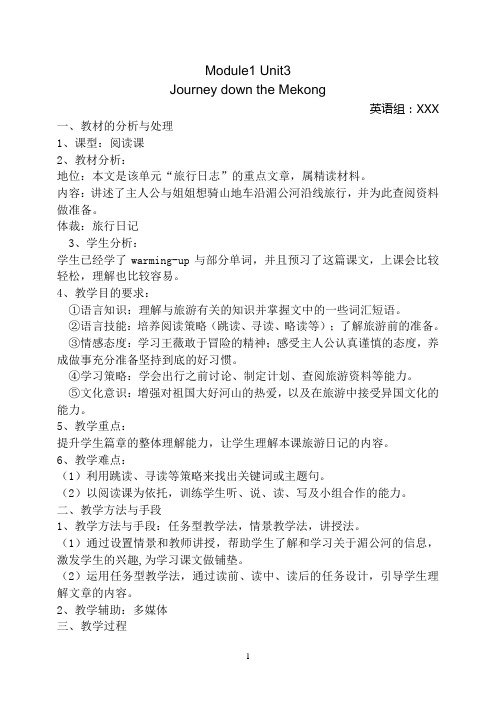
Module1 Unit3Journey down the Mekong英语组:XXX一、教材的分析与处理1、课型:阅读课2、教材分析:地位:本文是该单元“旅行日志”的重点文章,属精读材料。
内容:讲述了主人公与姐姐想骑山地车沿湄公河沿线旅行,并为此查阅资料做准备。
体裁:旅行日记3、学生分析:学生已经学了warming-up与部分单词,并且预习了这篇课文,上课会比较轻松,理解也比较容易。
4、教学目的要求:①语言知识:理解与旅游有关的知识并掌握文中的一些词汇短语。
②语言技能:培养阅读策略(跳读、寻读、略读等);了解旅游前的准备。
③情感态度:学习王薇敢于冒险的精神;感受主人公认真谨慎的态度,养成做事充分准备坚持到底的好习惯。
④学习策略:学会出行之前讨论、制定计划、查阅旅游资料等能力。
⑤文化意识:增强对祖国大好河山的热爱,以及在旅游中接受异国文化的能力。
5、教学重点:提升学生篇章的整体理解能力,让学生理解本课旅游日记的内容。
6、教学难点:(1)利用跳读、寻读等策略来找出关键词或主题句。
(2)以阅读课为依托,训练学生听、说、读、写及小组合作的能力。
二、教学方法与手段1、教学方法与手段:任务型教学法,情景教学法,讲授法。
(1)通过设置情景和教师讲授,帮助学生了解和学习关于湄公河的信息,激发学生的兴趣,为学习课文做铺垫。
(2)运用任务型教学法,通过读前、读中、读后的任务设计,引导学生理解文章的内容。
2、教学辅助:多媒体三、教学过程Step1: Lead inAsk some students to present their dialogue.(The homework of last class)【设计说明】采用对话形式导入,营造出宽松的学习气氛,为学生全面的课堂参与作了铺垫。
Step2: Pre-readingShow students some pictures and maps to know more about the Mekong river, its two names and the route it flows out of China.1. Names: Lancang River and Mekong River2. Route: China-Myanmar-Laos-Thailand-Cambodia-Vietnam-South China sea 【设计说明】利用图片来了解湄公河,为课文第三段做铺垫,同时,激发了学生的兴趣和好奇心。
人教版英语必修一Unit 3(Reading:Journey down the Mekong)教案
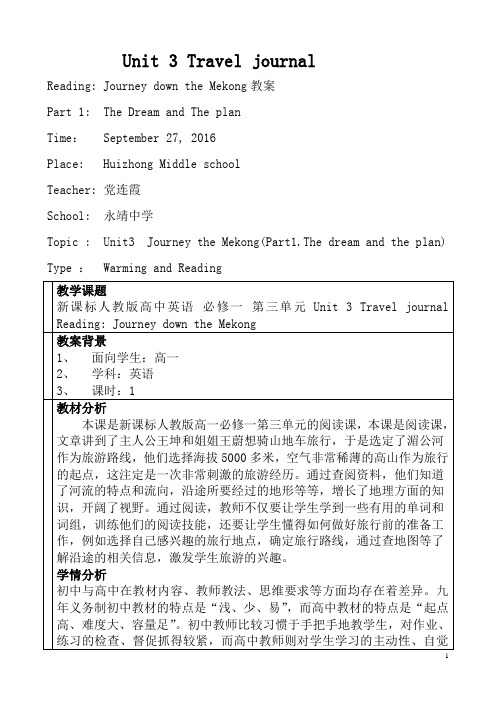
Reading: Journey down the Mekong教案
Part 1:The Dream and The plan
Time:September 27,2016
Place:HuizhongMiddle school
Teacher:党连霞
School:永靖中学
Para. 3The preparations before the trip & details about theMekongRiver.
•Who are Wang Kun and Wang Wei?
•What is their dream?
。Who are Dao Wei and Yu Hang?
4.Sometimes, the river becomes a ________ and enters ____ ______.
5.At last, the river _____ enters the South China Sea.
6.If you travel with them ,you will see all the following except
A. desert B. a waterfall
C. a delta D. a glacier
通过skimming及scanning阅读策略,引领学生关注文本的主题及涉及主题的主要信息。(也是这节课的重点和难点)
Step 4:Summary
Wang Wei and ____.___ have dreamed about ____ a great ___ ___.It was Wang Wei who first had the idea to ____ along the entireMekongRiver. My sister doesn’t ___________ details, because she doesn’t know the best way of getting to places.
人教版英语必修一Unit 3(Reading:Journey down the Mekong)教学设计
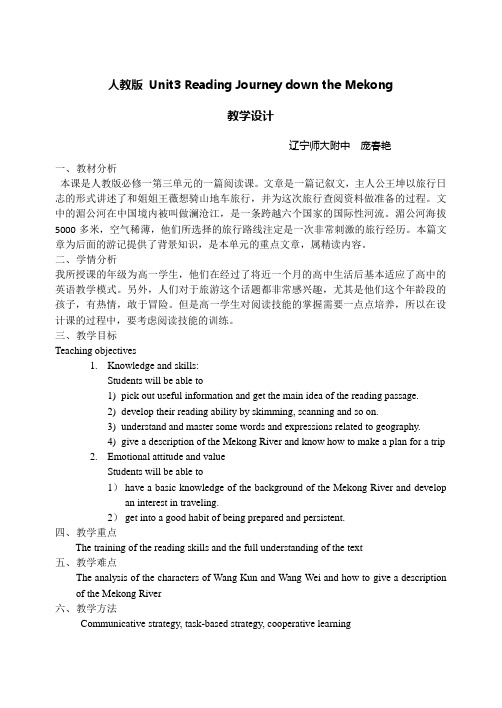
人教版Unit3 Reading Journey down the Mekong教学设计辽宁师大附中庞春艳一、教材分析本课是人教版必修一第三单元的一篇阅读课。
文章是一篇记叙文,主人公王坤以旅行日志的形式讲述了和姐姐王薇想骑山地车旅行,并为这次旅行查阅资料做准备的过程。
文中的湄公河在中国境内被叫做澜沧江,是一条跨越六个国家的国际性河流。
湄公河海拔5000多米,空气稀薄,他们所选择的旅行路线注定是一次非常刺激的旅行经历。
本篇文章为后面的游记提供了背景知识,是本单元的重点文章,属精读内容。
二、学情分析我所授课的年级为高一学生,他们在经过了将近一个月的高中生活后基本适应了高中的英语教学模式。
另外,人们对于旅游这个话题都非常感兴趣,尤其是他们这个年龄段的孩子,有热情,敢于冒险。
但是高一学生对阅读技能的掌握需要一点点培养,所以在设计课的过程中,要考虑阅读技能的训练。
三、教学目标Teaching objectives1.Knowledge and skills:Students will be able to1)pick out useful information and get the main idea of the reading passage.2)develop their reading ability by skimming, scanning and so on.3)understand and master some words and expressions related to geography.4)give a description of the Mekong River and know how to make a plan for a trip2.Emotional attitude and valueStudents will be able to1)have a basic knowledge of the background of the Mekong River and develop an interest in traveling.2)get into a good habit of being prepared and persistent.四、教学重点The training of the reading skills and the full understanding of the text五、教学难点The analysis of the characters of Wang Kun and Wang Wei and how to give a description of the Mekong River六、教学方法Communicative strategy, task-based strategy, cooperative learning七、教学过程【体现教学目标达成、教学重难点突破、教法学法说明】八、 板书设计。
人教版必修一UNIT3 journey down the Mekong 课件

Myanmar
Laos Vietnam
North
South
Thailand
Cambodia
Can you list the countries that the Mekong flows through?
which is the main idea of the passage?
A. The dream of Wang Kun and Wang Wei and their preparation for the bike trip.
(Part I: the dream and the plan)
Can you guess what the names of these rivers are?
The Changjiang River
Can you guess what the names of these rivers are?
we finally got the chance to take a bike trip.
Read Para.2 and answer the following questions.
1.What kind of person is Wangwei?
2.How do you know ? 3.Where is the source of the Mekong
Para.3 C. Deciding to take a great bike
trip along the Mekong river
Para.1 Read it and answer the questions.
1.How many people are there in the story?Who are they? 2. What was their dream?
人教版必修一Unit3-Journey-Down-the-Mekong-一等奖公开课ppt课件

Last year…
she visited our cousins, Dao Wei and Yu Hang at their college in Kunming. She got them intersted in cycling too.
When we graduated from college…
Para.1: Finish the following events
my sister Wang Wei and I have
Since middle school… dreamed about taking a great bike trip.
Two years ago…
she bought an expensive mountain bike. Then she persuaded me to buy one.
Ever since _m__id_d_l_e s_c_h_o_o_l_, Wang Wei and
I have _tr_i_p. It
dreamed about having was Wang Wei who first
a great had the
ib_di_ek_ae
to ____cyacloleng the entire Mekong River. My
Describe Wang Wei’s and Wang Kun's attitudes and Character
Character:
stubborn; serious; determined; clever; risk-taking; careful; wouldn’t change her mind;
After, it makes wide bends or meanders through low _v_a_ll_e_y_s_ to _p_l_a_in_s__.
高中英语人教版必修一《Unit3 Journey Down The Mekong about lan

6. The concert went like a clock work because Li Pei had ____o__rg_a_n_i_zeidt so well. 由于李佩组织的很好,所以音乐会进行的有条不紊。
4. Liu Xiaoding is a good teacher and ________ his students very much.
新课讲授
Find the correct words and the expressions from the text. Then translate them into Chinese.
4. The list of gifts was very long, and we don’t know why, but the most important ________i_t_e,mthe golden cup, was forgotten. (detail / item)
5. “How I wish I could make a ______jo_u_r_n_e_yinto space and see the stars up close!” cried Sarah. (journey / travel)
新课讲授
Find the correct words and the expressions from the text. Then translate them into Chinese.
3. My grandpa ___is_f_o_n_d__o_f fishing and sometimes he fishes all day in the river. 我爷爷爱好钓鱼,有时他整天都在江边钓鱼。
人教必修一unit3 Journey down the Mekong -reading课件(24张PPT)
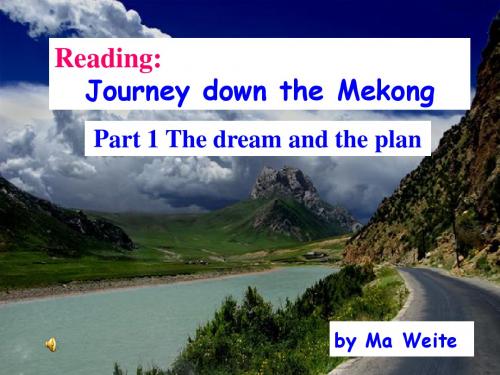
linking words
organize the structure and language logically in English writing
The dream and the plan
dream
(Para1) (Para2)
plan
(Para3)
content process
mental preparations difficulties attitudes
will have a journey down the Mekong
Brief Introduction to the Mekong River
▲
The Lancang River in China and enter the South China sea
● flow ● begin
through 6 countries
The Mekong River
● ●
have two names
▲
be the longest river in Southeast Asia, a distance of 4200 km
Brief Introduction to the Mekong River
be one of the richest areas of plants and fish species
a series of practical plans, including make full preparations for the trip.
●Life is just a series of trying to
make up your mind.
●Success always belongs to a
人教版高中英语必修1Unit 3课文讲解
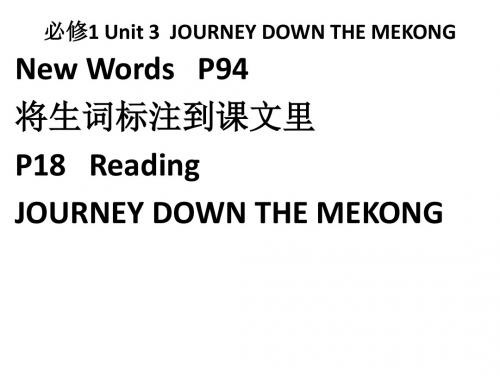
而下的旅程NG
They are Dai傣族人 and grew up in western Yunnan Province云南西部 near the Lancang River澜沧江, the Chinese part of the river that is called the Mekong River湄公河 in other countries. Wang Wei soon got them interested in cycling使他们对骑自行车旅行也产生 了兴趣 too. After graduating from college,we finally got the chance to take a bike trip.骑自行车旅行的机会
必修1 Unit 3 JOURNEY DOWN THE MEKONG
I asked my sister, “Where are we going?” It was my sister who first had the idea首先想到 to cycle along the entire Mekong River from where it begins 源头to where it ends终点. Now she is planning our schedule制 定计划 for the trip.
必修1 Unit 3 JOURNEY DOWN THE MEKONG
Several months before our trip , Wang Wei and I went to the library. We found a large atlas 大型地图册with good maps that showed details of world geography里面有 世界地理的明细. From the atlas we could see that the Mekong River begins发源于 in a glacier冰川 on a Qinghai mountain. At first the river is small and the water is clear and cold. Then it begins to move quickly. It becomes rapids急流 as it passes through deep valleys深谷, travelling across western Yunnan Province云南西部
人教高中英语必修1 Unit 3 Journey Down The Mekong 单元课件(共71张)

ever since: 1).自从那时 (单独用作状语,用于现在完 成时/现在完成进行时)
2).自从· · · (引导时间状语或时间状语从 句,从句用一般过去时,主句用现在完 成时/现在完成进行时)
prefer sth/ doing to sth/ doing 喜欢(做)· · · 胜过于(做) · · ·
prefer to do rather than do 宁愿做· · · 而不愿做· · ·
prefer sb to do 宁愿某人做· · · preference n. 偏爱 have a preference for · · · 偏爱· · ·
I often persuade him_n_o_t__t_o_p_l_a_y (play) the phone when crossing the road.
persuade v.s. advise
强调劝说的结果,说服了,成功了→persuade 强调劝说的动作,可能成功,可能失败→advise
不要买太多肉). 3).She wanted _________(说服我们相信她的诚实). 4).He __________(宁愿呆在家里也不愿意去看电影). 5).I __________________(喜欢唱歌胜过于跳舞). 6).We ________(宁愿你完成这个工作) by yourself. 7).She is a ____(大学毕业生)of Beijing University. 8).She _________(从大学毕业) two years ago. 9).He became a teacher after his ______(毕业)
人教版高中英语必修1 Unit3 Journey Down the Mekong教案

Unit3Travel JournalJourney Down the MekongTeaching Aims1.To talk about traveling and how to make preparations for traveling by brainstorm and free talk.2.To learn something about the Mekong River by a brief introduction of a student.3.To guide students to find out the main idea and some details in each paragraph by sc anning and skimming the passage.Teaching important pointsTo comprehend the text is very important.Get students to find out the main idea and s ome details in each paragraph.Teaching difficult pointsHow to grasp the main idea of the text and how to tell the writer’s attitude Teaching procedures&ways教学过程和方法Pre-readingTask1: Warming upShow some beautiful pictures of famous places on the PowerPoint.(The Great Wall; Budala Palace;Forbidden City;Eiffel Tower;etc.)Ask students whether they know where they are.Task2: Free talkT:Do you like traveling?T:Why do you like traveling?(Enjoy beautiful scenery;Increase our knowledge;Make friends;Be good to health…T: If you have a chance to travel,how are you going there?(on foot;by bike;by bus;by car;by plane/by air;by boat/by ship/by sea)Task3:BrainstormMany people live beside a river,how do they make use of it in their daily life.The suggested answers:People can drink the water in a river or wash their clothes.People can swim in a river in summer.People can use a river to irrigate their fields.People can use a river to produce electricity.People can travel along a river; Raise ducks;While-readingThere are many great rivers in the world. Have you ever dreamed about travelling along one of them? Today we will follow Wang Kun and Wang Wei to travel along the Chinese part of Mekong River.Task 1 One student will introduce the Mekong River.Task 2 Co-operation study,After listening, skim the passage and find out the answers to the following questions para by para.Para.11. What was Wang Kun and Wang Wei’s idea of a good trip?2. What is the Chinese part of Mekong River?3. Who planned the trip to the Mekong?Para.21. Did Wang Wei know the best way of getting to places?2. Who insisted on organizing the trip? Why?3. What’s Wang Wei’s attitude to the trip?4. What’s Wang Kun’s attitude to the trip?Para.31. Where is the source of the Mekong and which sea does it end?2. Translate the following sentence in Chinese.It makes wide bends or meanders through low valleys to the plains where rice grows.Task 3Co-operation study fill in blanks with the help of illustrationsThe Mekong River is called _____________ in China. It goes through ____________ _____, _________, _________, _________ and pours into the ________________.Wang Kun and ___ _____ Wang Wei are dreaming about ____________________. They have the idea to _____ ______ the Mekong River from ______ it ______ to ______ it _____.It begins in a _______ on a ________ _________. Then, it ______ quickly. It becomes______ as it passes through deep ______.Sometimes, the river becomes a ________ and enters ____ ________.At last, the river _____ enters the South China Sea.Post-reading:DiscussionIn groups of four, summarize the main idea of the passage and tell why.(The passage tells us a main idea that no success in life merely happens by describing my sister’s and my dream---taking a bike trip and preparations for the trip.) Homework:Imagine that you are Wang Wei, tell your classmates your experiences about your traveling, and write it down.。
人教版英语必修一Unit 3(Reading:Journey down the Mekong)教学教案

Unit 3 Travel journalJiang Guiping(蒋桂萍)Lesson: Reading1, Journey down the MekongPeriod: the second periodTeaching target:1. Cognitive target:Important words and expressions:persuade, graduate, finally, schedule, organize, journey, attitude,ever since, persuade sb. to do sth., be fond of, care about, give in, dream about, graduate from, get the chance to do sth., change one’s mind, make up one’s mind, keep doing sth.2. Ability target:(1).Learn something about the Mekong River through reading.(2). Students can use what they have learned to prepare for a trip(3).Develop the students’ reading ability and let them learn to use some reading strategies such as skimming, scanning.Teaching important and difficult points:1. Understand the text well.2. Try to master the useful new words & expressions in this period.Teaching aids: a computerTeaching method: Task-based teaching methodTeaching procedure:Step 1 Lead in1 .Pictures showing. Let the Ss get some information about some great rivers in China and the world.2. Let the Ss know how important these great rivers are.3. Let the Ss get some brief information about the Mekong River by watching a video. Task: List the countries that the Mekong River flows through after watching the video.Step 2 Fast readingTask 1. Answer the question: What’s their dream?Task 2. Match the main idea with each paragraph.Para.1 A. The preparation before the trip and details about MekongriverPara.2 B. Different attitudes between Wang kun and Wang WeiPara.3 C. Taking a great bike trip along the Mekong riverStep 3 Careful readingTask 1. Read the first paragraph and answer the following questions:1. Who will travel down the Mekong River?2. How are they getting there?3. Who will prepare for the trip?Task 2. Read the second paragraph and answer the following questions:1.What did Wang Wei prepare for the trip?1) Two years ago,……2) Then , ……3) Last year, ……4) Several months before our trip, ……2. What didn’t sh e prepare for the trip?1).She didn’t know……2).She hadn’t ……3).She doesn’t……Task 3. Read the third paragraph and fill in the blanks.It begins at a ________ on a _________ in Qinghai province. Then, it movesquickly. It becomes______ as it passes through deep _____. Sometimes, the river enters ____ _____and becomes a _______ . After it leaves China and high altitude, it becomes , and . After, it travels slowly through low ______ to the . At last, the river’s _____ enters the South China Sea.Step 4. Post readingTask. Reading comprehension:1. Which sentence is true according to the text?A. Wang Wei advised Wang Kun to buy a mountain bike and he agreed.B. Wang Wei often listened to others.C. Before their trip they didn’t go to the library.D. Wang Wei knew the best way of finding the source of the river.2. When you travel along the Mekong River, maybe you can not see .A. waterfallsB. desertC. plains where rice growsD. Valleys and rapids3. What kind of person is Wang Wei? Which answer is wrong ?A. stubbornB. determinedC. adventurousD. careful(喜欢冒险的)Step 5. listening and SummaryA summaryWang Kun and Wang Wei have _________ about taking a great bike trip. When they __________ from college. They _______ to _____ along the Mekong River with their ________. Wang Wei is very _________. Once she is __________ to do something, she will never _______ her mind. Although it is difficult to travel along theMekong River by bike, she ________ that they find the ________ of the river and begin their journey there.Step 6. DiscussionImagine you are helping the cyclists to prepare for their trip down the Mekong. Which of the following objects do you think is the most useful? Why?(Show some pictures of the objects that are widely used during a journey to let the students choose from. The students discuss it with their partners at first. Then, ask some students to express their opinions.)Step 7. Homework1. Finish exercises on page 562. Underline the useful expressions in the text.。
